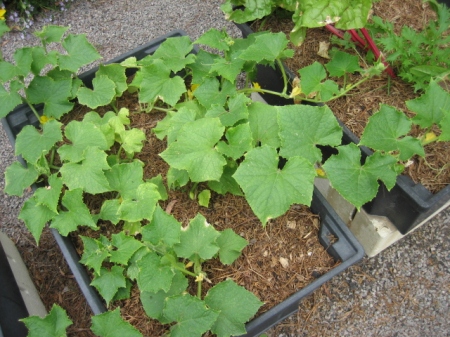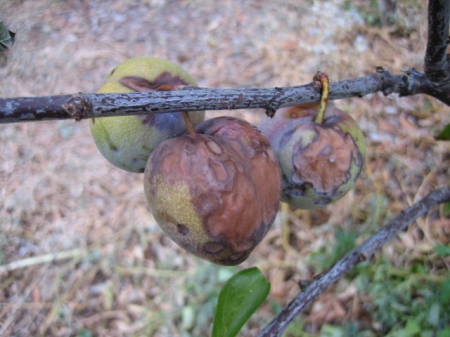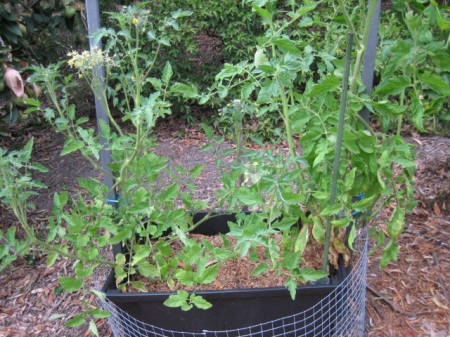I took the camera around the garden this morning (loving the coolness!) to assess the damage.
The most important thing is to learn from this. If this sort of weather is going to be the new normal, we have to learn and adapt or die. Natural selection eliminates the unfit and preserves that which adapts and survives. That goes for us, our gardens and our animals.
So…
Most important, three happy chooks who survived:
It was upsetting to see that both Green Gavin and rabidlittlehippy each lost a hen to heat distress. In my case, the Girl’s secure run and playground is close to the house on the morning sun side. Once the sun goes over the house there’s shade at least on the secure run. There’s also a large tarp over the top and a row of greenery along one side. I covered the floor there with leaves and kept them wet. The Girls made themselves a hollow in the wet leaves and sat there during the hottest part of the day. I pegged a heavy old curtain over the playground and sprayed it every half-hour with the hose. Eventually going out into the sun to do it started to stress me out, so I used the hose which I always connect to the cold water outlet of the washing machine on fire risk days and with that I could stand in the laundry doorway and spray all over the chook’s area, without going outside.
In the garden, the first thing to notice was that everything in wicking boxes was unaffected. Frogdancer has also commented that her wicking boxes were OK. I think it’s the way to go. I lost some cucumbers planted in the garden down the back, I’m guessing because they were lacking sufficient water at the roots. These cucumbers in a wicking box were unaffected. Not even any burned leaves (no, I didn’t cut them off for the photo!):
So long as there’s plenty of water in the root zone, plants won’t be too badly affected. Even if I think I’ve watered the garden well, that sort of weather really rips it out of the plants and if there’s no adequate reserve in the soil, the plants suffer. In a wicking box the soil below the drainage holes is always saturated. I could have watered every second or third day and still not have lost any plants. The only thing I did was cover the beans in wicking boxes with shadecloth. Those large leaves lose water faster than they can take it up and even though there’s plenty of water in the root zone, the leaves will fry.
Down in the food forest there was a lot of damage. Unfortunately, it’s on a slope (the only place on the property that was cleared of existing vegetation), and the soil is heavy and compacted. It’s hard to get water into it. If I stand there holding a hose, within a couple of minutes the water’s running off, so I water by gravity from the tank using a fine spray, which means it takes ages to water the whole area. The furthest parts were really dry and plants there suffered.
The loquat’s large leaves really burned:
The comfrey just lay down and (almost) died:
That’s not a problem, though. I’ll cut it back and stuff it into a bin of water and make nutrient tea. I’d been going to do it anyway, but just hadn’t got around to it.
I’d picked all the Satsuma plums, but there were a few on the Mariposa that were still green. They’re not green any more:
Anyone for stewed pears?:
The rhubarb plants in the hugelkultur mound were OK as they had dappled shade from eucalypts, but this one was out in the open:
I’d been giving the tamarillos plenty of water, but those dinner-plate sized leaves were not going to like the heat regardless:
The developing fruits were mostly OK but a few got a bit of a tan:
Here’s one surprise…the asparagus fern. It hasn’t had any water except rain since I stopped picking the spears in November, yet it was untouched. Since it’s about 2 metres tall, it makes me think a row of asparagus might be a good shelter for a row of something smaller, say strawberries:
The corn was fine. I’ve been pumping water into it and it had a tamarillo for afternoon shade:
Another surprise was the quince. It’s next to the loquat, so is in a dry spot, but look at the new tip growth. Green and unburnt. Those dark spots on the older leaves are the fungus disease it always gets—quince rust, I think—not burned areas. Maybe this is another plant that can tolerate dryness and be used as a shade tree:
You know it’s hot when bracken will burn. This frond was out in the open, but even so:
Redcurrants won’t tolerate hot sun. I knew this from last year and should have protected them:
Burnt apples:
And right in the middle of it all, tomatoes in a wicking box, untouched:
What have I learned? Wicking boxes are the way to go for vegetables. They’re small, so individual shade can be erected, if necessary over a single box. Plants with large, soft leaves, like beans, need shade even in a wicking box. Site them so that they receive morning sun only. Poke the boxes in behind a tall plant that shades them from the afternoon sun. I have a row against the side of the deck, which gets only morning sun.They were fine.
Cover any developing fruit. If you can’t keep water up to everything, prioritise. I’m letting one orange tree go, the Lane’s Late Navel. It’s never been a good bearer and I have a Valencia and a Washington Navel which are better trees and get priority. It’s under the drip line of a eucalypt and even though it gets afternoon shade (it wasn’t burnt) it competes poorly for water. When I take it out I’ll put a couple of wicking boxes in it’s place. They’ll get shade from the eucalypt and the plants in them won’t have to compete with its roots.
Look after your animals. That goes without saying. The chooks were my biggest worry. I’d have taken them inside if I could. I bought a half-watermelon at the beginning of the week and gave them some every day. They love it and it helped to keep them hydrated. I didn’t get any myself!
I’m still making notes about what did well and what didn’t and how I can change things for a better outcome next time. I think it’s safe to assume summers like this are going to be the norm from here on.
















January 18, 2014 at 9:27 pm |
I am so lucky as far as the garden went. The only damage done is what was burned during the first few days and only in the greenhouse. My gardens wilted a little but but everything seems to have survived. My baby rhubarb has some singed leaves but I have tomatoes, flowering sunflowers, zukes, punks and spag squash all flowering. I think my comfrey survived (I forgot to check) and the other large comfrey is right beside the pond so that may have helped it with its own microclimate but most of it would have seen late afternoon sun only anyway. The salsify exploded into seed (there’s a good crop to plant I’d say :D) and the only other dried out plants were those already suffering in a poor hugel. I’m stoked at how well things in the garden survived. Clearly though we have much thinking and work to do for the animals. 😦
LikeLike
January 19, 2014 at 6:40 pm |
Good to see someone had some positive outcomes! Maybe it was a fraction cooler where you are or maybe your soil moisture content was adequate. There are so many variables that determine how plants cope. What a huge learning curve we’re all on!
LikeLike
January 19, 2014 at 7:47 pm |
It is generally cooler here than in and around Melbourne. And our place is that little bit cooler than up in town. We’re in one of the lowest points in Ballan from what I can make out which is rotten in winter. Forecasts of -2 mean -2 for town but -7 for us. Still, we reached 39 here and the rest of town was 44. It’s not all bad.
LikeLike
January 19, 2014 at 10:31 pm |
It seems that if you’re a plant, there’s a huge difference between 39 and 44. You can get by at 39, but 44 tips you right over your limits and into plant hell.
LikeLike
January 20, 2014 at 9:27 am |
I have to agree with that. I found myself able to sit and do nothing and be relatively omfortable once the temperature was 37 or under. Above and even sitting was awful.
On further inspection I’ve had a few tomatoes in the greenhouse with singed leaf ends, my spuds in pots have a little leaf damage but nothing to write home about. My little walnut is cooked but I don’t know if he might just make it. They’re pretty tenacious. All bar one of the whipper snippered trees grew back. 🙂
My rhubarb has singed leaves as do my sunflowers which are flowering though thanks to the heat, my nasturtiums are ll ooked and crispy mulch and the celery are the same. Still, my main crops, potatoes, pumpkins and tomatoes are all happy as larry and the beans and carrots are too. Oh my parsnip have a few singed leaves too but they’re essentially ok. All in all I am well impressed.
LikeLike
January 18, 2014 at 10:09 pm |
So THAT’S why my scarlet runner beans were the only things that died.
I was going out in the afternoon once a day and hosing down my chooks. They weren’t happy about it but they all survived. I was most worried about the ones in the chook tractor … being in a metal cage in 45C heat?? But they all made it through.
LikeLike
January 19, 2014 at 6:43 pm |
My chooks didn’t like being hosed directly. It freaked them out. When you think of it, the water is only going to run off and get nowhere near their skin where it would cool them.
I had beans under mosquito netting for shade and they still burned a bit.
LikeLike
January 18, 2014 at 10:34 pm |
Your wicking boxes sound like a great idea. I will have to implement a few for some extra veggies that may struggle next year. Mine you, this growing season is far from over yet.
Thanks for the tip, and the link.
Gav x
LikeLike
January 19, 2014 at 6:47 pm |
They’re great for things like celery which likes water. The only plant I’ve found that doesn’t do well is dill. The roots seem to rot really quickly. I’ve never tried carrots yet…it’s on the To Do list. They do save a lot of frequent watering and cut down the work a bit.
LikeLike
January 19, 2014 at 3:32 am |
Asparagus grows wild here all over the place so I knew that it was drought tolerant, indeed hardy and quinces are Mediterranean like figs and olives so should be able to take a hit of heat. I was amazed to see (On Rabids pilfered map) that the heat wave band extended from Perth to Geraldton in W.A. and down through Tasmania! TASMANIA!!! Aren’t we supposed to be cold here? Isn’t that why I bloody well moved here?!!! Looks like I should have stayed in Albany W.A. as they only had mild temperatures in the low 20’s! Sigh…in saying that, the ex fishfarm netting appears to be a great foil against the sun. The sun is particularly vicious here in Tasmania thanks to the lack of an ozone layer for protection but the thick dappled sunlight in the enclosed garden gives the plants enough protection and increases the humidity inside the area thus making a plants paradise. I am also using hugels inside rather than standard garden beds (aside from my existing veggie beds that I decided to use this year and will pull apart at the end of the season). Learning lots of lessons from this post. Cheers for sharing 🙂
LikeLike
January 19, 2014 at 6:49 pm |
Hugels are great! All the garden rubbish about the place can be thrown in a huge heap, covered with a nice-looking mulch and you’d never guess what’s under there 😉
LikeLike
January 20, 2014 at 3:45 am |
The answer to my problems then! We have SO much garden waste as we hack our way through 25 years of neglected jungle that we have been stacking it in large piles and I am sure our neighbours are starting to get worried for the fire risk AND that we are going to burn them like Wicker Men on the day of SummerIsle 😉 Making hugels would be a win-win opportunity to make those piles less ugly, more useful and not necessary to cart them away to green waste. I just have to find a way to hack up the debris in smaller bits that isn’t going to render me knackered for 2014. I was thinking about forming hugel swales (digging soil around here isn’t an option thanks to all the rocks in the ground) to harness the rainwater that rockets down the slopes on the property (we are just 1 big 4 acre steep slope leading into the Tamar River) and slow it’s descent to give it time to soak into the ground. It would also give a terraced look (without the digging). What do you think? I value your opinion 🙂
LikeLike
January 20, 2014 at 6:01 am |
Answer coming up in a separate post about swales.
LikeLike
January 20, 2014 at 4:31 pm |
Cheers 🙂 Can’t wait for it 🙂
LikeLike
January 19, 2014 at 9:16 am |
[…] foodnstuff has written a cracker of a post about how her garden and gerls survived the heatwave (or not). She also found that her wicking boxes worked brilliantly, though I was shocked to see the photos both she and Bek posted of apples cooked on the trees. Mine all came through unscathed. […]
LikeLike
January 19, 2014 at 1:16 pm |
Glad to see no chicken casualties with the girls. If you’re looking for ideas to help them in the future, contemplate whatever jungle foliage you can plant around them – either in pots or straight in the ground. You shouldn’t have to water them down as much.
Once the foliage and ground is wet, it takes longer to evaporate. I wonder if a small bamboo (var multiplex) in a pot, would work? Even a die-hard geranium, which doesn’t loose moisture out of its leaves as fast, might help too. If you keep them in pots, you can move them out of the way when its cooler, to give more light.
I’d use terracotta pots though, as the black plastic variety might hold heat longer.
Tamarillos are (I think) traditionally an understory tree, but I think you’re onto something with the wicking boxes. Maybe you could look at digging some swales near your fruit trees to hold water in the ground longer. Ours have been crucial to growing anything here. In fact, where we don’t have swales, we have erosion and dead soil. We live in a clay pan with shelves of sandstone.
I also interplant my fruit trees with pigeon peas, as I’ve found the latter helps build better soil. The fruit trees take nutrients from the soil, and the pigeon peas feed the soil. PP don’t die in the extremes either. Wherever I plant them, they don’t get any attention from me, yet they’re constantly flowering and pushing out foliage. Chickens love PP’s too, especially scratching and resting underneath them.
Glad to see some success stories in your garden, along with the unfortunate losses. You’re thinking about intelligent design now, and that can only build a more resilient system. I like the idea of asparagus and strawberries. 🙂
LikeLike
January 19, 2014 at 6:54 pm |
I’ve got a few wicking boxes around the outside of their playground and that provides some greenery (except that they eat what they can reach). It also means I don’t have to bury wire against foxes. No fox could ever move or dig under one of those things!
I have done swales behind each fruit tree and will be doing a post about that soon.
I will check out the pigeon peas. I have trouble with a lot of similar plants because the rabbits like them. Thanks for all the good tips.
LikeLike
January 20, 2014 at 9:34 am |
Sad to see so much damage, but I am inspired by the wicking bed survivial rates. My bush and climbing beans were far and away my most affected veg, and I think I’ll be planting them in part shade next year. My asparagus looks completely unaffected by the heat, so I think they would be fine and make a good shady spot.
LikeLike